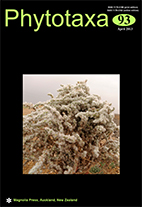Abstract
An expanded description of Salvia platyphylla with new insights based on the examination of recent herbarium specimens and observations made in the field is provided. Additionally, are included descriptions and illustrations of two new species morphologically similar to S. platyphylla. The first, S. pugana, can be distinguished from S. platyphylla by its larger calyces, magenta corollas with larger and internally epapillate tubes, longer filaments and connectives, and wider nutlets. The second, S. albiterrarum, differs from the latter by its longer corolla tubes, absence of patent white nectar guides on the lower lip, longer filaments, longer and not geniculate connectives, longer styles, with the branches and 3–5.3 mm of the apical portion exserted from the upper lip, and lower stigmatic branch straight rather than sigmoid or arquate. The three taxa are sympatric and represent western Mexico endemisms. Lastly, floral morphology differences between these species suggest valuable considerations on pollination syndromes.

